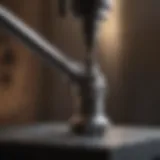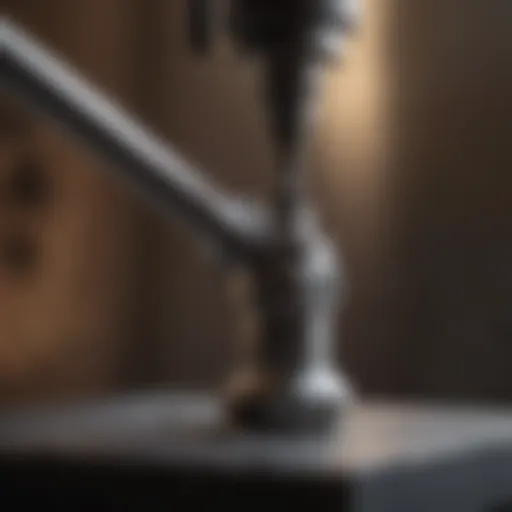Comprehensive Guide to Replacing Window Shutters
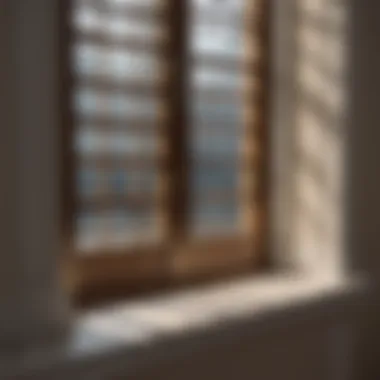

Intro
Replacing window shutters is a significant aspect of home improvement that often goes overlooked. Shutters serve both functional and aesthetic purposes in a home. Functionally, they provide privacy, protect against the elements, and can even improve energy efficiency. Aesthetically, they can enhance curb appeal and reflect the personal style of the homeowner.
A well-executed shutter replacement can elevate the appearance of a house entirely. Conversely, old or damaged shutters can detract from a home’s look and functionality. Therefore, understanding how to properly replace window shutters is essential for homeowners looking to improve their environment.
Importance of the Topic
The importance of replacing window shutters transcends mere appearance. High-quality shutters can enhance insulation, which helps lower heating and cooling costs. Additionally, they contribute to noise reduction, giving homeowners a quieter living space. From a security perspective, shutters provide an added layer of protection against intrusions.
Moreover, shutters can reflect personal aesthetics. Whether a homeowner prefers classic designs or modern styles, shutters are available in various materials, colors, and shapes. This variety allows for customization that can suit any home style. Understanding how to choose and install the right shutters can lead to improved satisfaction with one's living environment.
Common Challenges and Solutions
Homeowners often face several challenges when replacing window shutters. Recognizing these issues can help in finding effective solutions.
Common Issues
- Sizing Errors: One common issue is selecting the wrong size for shutters. Incorrect measurements can lead to misalignment and functionality problems.
- Material Mismatch: Selecting shutters that are not suited for the local climate can result in premature wear and tear.
- Installation Mistakes: Improper installation can affect the shutters' longevity and effectiveness.
Solutions and Tips
- Accurate Measurement: Take precise measurements of the windows and consider consulting with a professional if unsure.
- Choose the Right Material: Research materials suitable for local weather conditions. For example, vinyl is often durable in humid areas, while wood can add elegance in temperate climates.
- Follow Instructions: Adhere to manufacturer specifications for installation. Watching video tutorials or following detailed guides can also be beneficial.
Replacing window shutters offers a unique opportunity to enhance home function and style, directly impacting the homeowner’s quality of life.
Product Recommendations
When selecting shutters, it is crucial to invest in high-quality products. Here are top recommendations based on performance and customer satisfaction:
- Bahama Shutters: Ideal for tropical regions, providing ventilation and shade while effective against storms.
- Plantation Shutters: Known for their versatility, these shutters provide privacy and light control.
- Exterior Vinyl Shutters: Lightweight and resistant to moisture, perfect for low-maintenance needs.
Each of these products has unique features that cater to different homeowner needs. For instance, Plantation shutters are not only functional; they also add an elegant touch to interiors.
Step-by-Step Guides
Implementing improvements related to window shutter replacement requires careful planning. Follow these practical steps:
- Assess Your Needs: Understand why you want to replace your shutters. Is it for aesthetics, functionality, or both?
- Select the Type of Shutters: Choose based on functional needs and design preferences.
- Gather Necessary Tools: Common tools include a level, tape measure, drill, and screwdrivers.
- Measure Windows Accurately: Double-check measurements to ensure correct sizing.
- Install Shutters: Follow the manufacturer's directions closely for the best results.
- Finalize and Enjoy: After installation, ensure shutters function correctly and appreciate the enhanced look of your home.
Understanding Window Shutters
Window shutters hold significant value in enhancing both the aesthetic and practical aspects of a home. They are not just a decorative element; they serve multiple functional purposes that can influence a homeowner's decision when considering replacement options. Understanding window shutters allows individuals to better appreciate their roles, analyze their types, and recognize when replacement is necessary.
Types of Window Shutters
A thorough grasp of the various types of window shutters is essential for homeowners. Each type has unique characteristics that cater to specific style preferences and functional needs.
Traditional Shutters
Traditional shutters are among the most recognized. They often come in wood, providing a classic look that can complement many architectural styles. One key characteristic is their hinged design, allowing them to be opened or closed depending on the desired exposure to light.
Their benefits lie in their timeless appeal and customization options, making it easy to match the existing home decor. However, their maintenance can be demanding, given that wood requires regular staining or painting to protect against weathering.
Plantation Shutters
Plantation shutters are another popular type that offers a modern twist. They often feature larger slats, which not only create a stylish look but also improve light control compared to traditional shutters. The ability to adjust the slats provides flexibility in managing sunlight and privacy levels, making these shutters particularly beneficial in warmer climates. The downside is their usually higher initial cost, which may not fit every budget.
Board and Batten Shutters
Board and batten shutters offer a rustic charm and are commonly seen in cottages or farmhouse-style homes. This type consists of vertical boards secured with horizontal battens. Their robust structure contributes to their popularity, as they provide both privacy and added insulation. However, their rustic appearance may not suit more modern or traditional homes.
Fabric and Roller Shutters
Fabric and roller shutters introduce a different element, often utilized for their sleek and simple design. These are particularly effective for blocking light and controlling temperature. The main advantage is their ease of use since they can be easily rolled up or down. Yet, they might lack the durability found in wooden options and can show wear more rapidly over time.
Functional Importance of Shutters
Understanding the functional importance of shutters can greatly influence the decision on whether to replace them. They serve essential roles beyond mere decoration.
Light Control
Light control is one of the primary functions of shutters. Properly crafted shutters allow homeowners to regulate the amount of light that enters a room. This can create a soothing ambiance or protect furnishings from sun damage. When considering replacement, the choice of materials and designs can affect how effectively light control is achieved.
Privacy Considerations
Shutters provide an essential layer of privacy, shielding the interior of a home from external views. The design of the shutters can greatly impact how much privacy they offer. Effective privacy considerations lead to selecting types of shutters that can be adjusted as per the home's orientation relative to the surroundings.
Energy Efficiency
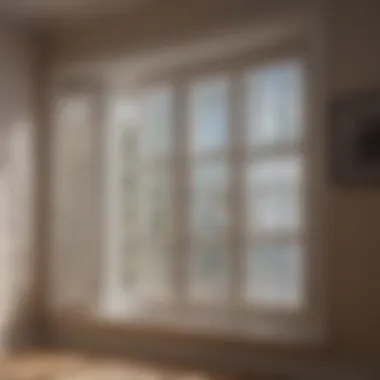

Energy efficiency has grown in importance for many homeowners. Good quality shutters can improve insulation, thus helping to keep the home cool during summer and warm in winter. This is an essential factor to consider during replacement, as energy-efficient shutters can impact the heating and cooling costs over time.
Identifying When to Replace Shutters
Identifying when to replace shutters is crucial for maintaining the overall aesthetic and functionality of a home. Shutters play a significant role in controlling light and privacy, as well as adding character to the property. Recognizing signs that indicate replacement can lead to improved energy efficiency, enhanced curb appeal, and a more comfortable living environment.
Signs of Wear and Tear
Paint Damage
Paint damage is often the first visible sign of wear and tear on window shutters. When the paint begins to chip, fade, or blister, it not only affects the look but also exposes the underlying material to elements, increasing the risk of decay. A well-maintained paint job is essential, especially in climates with extreme weather conditions.
Painted shutters are popular due to their aesthetic flexibility. Homeowners can choose colors that align with their home's exterior design. However, neglecting paint upkeep can lead to more severe problems. Repainting can be an immediate solution but may signal that replacement is necessary if damage is extensive.
Structural Issues
Structural issues refer to any physical damage that affects the integrity of the shutters. This includes warping, cracking, or splintering. Such problems can occur due to moisture exposure or temperature fluctuations. The ability of shutters to function properly is greatly affected by these structural compromises.
When structural issues are evident, homeowners must decide between repairing and replacing. Repairing can sometimes extend the life of the shutters but may not guarantee long-term results. Replacement is often a more reliable choice, especially if the shutters are older or have multiple issues.
Operational Difficulties
Operational difficulties include any problems that affect the ease of use of the shutters. This can mean they do not open or close smoothly or are misaligned. These issues can arise from long-term wear, improper installation, or damage.
Addressing operational difficulties is important for maintaining comfort and functionality. Ignoring such problems can lead to frustration and may inhibit accessibility. When the effort to operate the shutters surpasses their intended function, it is time to evaluate replacement options.
Evaluating Style Changes
Outdated Designs
Outdated designs can detract from the overall appeal of a home. Styles can evolve over time, and what was once trendy may now seem stale. Homeowners might feel that their current shutters no longer reflect their taste or align with modern design trends.
Replacing outdated designs can significantly enhance the home’s aesthetic. Newer shutter styles may offer improved functionality and appearance. Therefore, the decision to replace hinges not only on physical condition but also on how well the shutters integrate with current home decor.
Changing Home Aesthetics
Changing home aesthetics can stem from renovations or shifts in personal taste. A homeowner might decide to update their shutters to harmonize with new exterior colors or architectural styles. This choice can redefine the home's character and enhance its market value.
Considerations related to changing home aesthetics may include materials and colors that match the broader design scheme. Replacement in this context transcends superficiality. It reflects intentionality in creating an appealing environment that resonates with homeowner desires.
Planning for Replacement
Planning for the replacement of window shutters is critical to achieving a successful installation. This stage involves evaluating your current shutters and understanding the specific requirements that will guide your selection. The proper planning phase can save time and resources by ensuring that the right materials and sizes are chosen from the start. It allows homeowners to align their aesthetic preferences with practical needs. By focusing on key aspects such as materials, dimensions, and style compatibility, the entire process becomes easier and more efficient.
Choosing Suitable Materials
Wood vs. Composite
Choosing suitable materials begins with the consideration of wood versus composite options. Wood shutters provide a classic and timeless look. They are durable and can add warmth to any room. However, they require regular maintenance to keep them looking their best. Composite shutters, made from engineered materials, offer similar aesthetics at often lower costs. They resist warping and fading more effectively than wood. Therefore, each choice has pros and cons that depend on your specific situation.
Vinyl Options
Vinyl options are increasingly popular due to their affordability and variety. These shutters are lightweight and easy to install, making them accessible for DIY installations. Their key characteristic is low maintenance; they do not require painting or staining. However, vinyl may not provide the same level of insulation as other materials. Weighing these features is important in deciding if they are suitable for your home.
Aluminum Alternatives
The option of aluminum is also worth considering. Aluminum shutters are known for their strength and resistance to the elements. They do not warp or rot, unlike some wood options. This makes aluminum shutters a practical choice for homes in humid climates. However, they can be prone to scratches and may require periodic maintenance to preserve their appearance. The durability and finishes available make aluminum an appealing choice in many cases.
Selecting the Right Size
Measuring Window Dimensions
Accurate size measurements are vital for a successful installation. Measuring window dimensions ensures that the new shutters fit perfectly without gaps or overlaps. If you measure incorrectly, it could lead to additional costs and frustrations. A key characteristic of properly measuring is the adherence to standard practices to reduce error. Use a measuring tape and note all dimensions carefully.
Considering Overlap Requirements
Overlap requirements are another key component. The way shutters overlap the window frame affects aesthetics and functionality. Considering this aspect provides a greater chance of achieving a polished look. Proper overlap can enhance light control as well as privacy. However, too much overlap can impede functionality. Balancing these factors is essential for a satisfactory outcome.
Design Aesthetics
Color Coordination
Color coordination enhances the visual appeal of your home. Choosing the right colors for the shutters can harmonize or contrast beautifully with your home’s exterior. This consideration not only increases the attractiveness of your home but also its value. It is beneficial to analyze your current color scheme and how the new shutters will fit.
Style Compatibility
Required Tools and Materials
Choosing the correct tools and materials is pivotal for a successful window shutter replacement. Using the right equipment not only simplifies the task but also ensures accuracy and durability. Adequate tools can minimize frustration and help achieve the desired result without needing professional help, potentially saving money in the long run.
Essential Tools


Measuring Tape
A measuring tape is essential in ensuring the new shutters fit perfectly into the window frame. This tool allows for precise measurements, which is crucial for preventing gaps, drafts, or misalignment. A good measuring tape typically has a sturdy, flexible design that can accommodate various window shapes and sizes.
Its feature of being retractable is a key characteristic that makes it user-friendly; it enables quick storage and easy handling. However, one disadvantage can be its susceptibility to tearing if used frequently in rough conditions. Being careful with it is necessary to maintain accuracy and extend its life.
Saw and Drill
Having a saw and drill is fundamental when it comes to cutting materials and making necessary holes for installation. The saw is crucial for trimming the new shutters to meet specific required dimensions accurately. It is particularly beneficial because it can handle different types of materials, making it versatile for various projects.
The drill, on the other hand, is instrumental for creating holes in the window frame for mounting the shutters securely. A key characteristic of the drill is its speed and efficiency, allowing for quick work. However, it can be challenging for beginners since misuse could lead to damage. Learning to handle both tools effectively is recommended for quality results.
Screwdriver Set
A screwdriver set is mandatory for fastening the shutters to the window frame. It allows for easy installation and removal of screws, which is essential in securing the shutters. A good set usually comes in multiple sizes, accommodating various types of screws. This versatility is a key advantage, as it provides options for different scenarios.
In some cases, a standout feature of screwdriver sets is their magnetic tips, which simplify handling screws and prevent dropping. However, a disadvantage can be the potential for losing smaller screwdrivers, which may lead to disruption in the installation process.
Materials Needed
New Shutters
New shutters are central to the project since outdated or damaged shutters can detract from a home's aesthetic and functionality. Selecting quality shutters is vital for ensuring longevity and effectiveness. There are numerous material options, including wood, vinyl, and composite. Each has its own benefits and drawbacks, but this variety allows homeowners to choose based on personal preference and home style.
A key characteristic of well-chosen shutters is their insulation properties, which can help improve energy efficiency. However, high-quality shutters often come at a steeper price, which is something to consider when planning.
Mounting Hardware
Mounting hardware is critical in the installation process. It includes brackets, screws, and anchors needed to affix the shutters firmly to the wall. Choosing quality hardware ensures the shutters are stable, enhancing safety and performance.
One key aspect of reliable mounting hardware is its durability. It withstands weather elements and supports the shutters over time. On the downside, some may find importing or sourcing specific hardware types challenging, particularly if they live in remote areas.
Paint or Stain
Paint or stain plays a significant role in enhancing the overall look of the new shutters. Proper finishing not only improves aesthetics but also adds a layer of protection against weathering. Using high-quality paint or stain can provide a beautiful finish and extend the life of the shutters.
The ability to customize color schemes is a key benefit, allowing for personal expression. However, one disadvantage is that certain paints might require multiple coats for adequate coverage, increasing time demands. Thus, planning the finish process is as necessary as the physical installation.
Step-by-Step Replacement Process
Replacing window shutters is not as straightforward as it appears at first glance. A precise and methodical approach is essential to achieving satisfactory results. This section provides a clear roadmap, breaking down the process into digestible steps. Following these steps not only streamlines your efforts but also aids in reducing mistakes that could lead to future complications. Each stage, from removal of old shutters to the installation of new ones, is crucial for ensuring your new shutters are functional and appealing.
Removing Old Shutters
Removing old shutters is the first necessary step when replacing them. This process involves careful consideration of the tools, techniques, and safety measures needed.
Tools Needed for Removal
To successfully remove shutters, certain tools are indispensable. These include a measuring tape, a drill, and a screwdriver set. The versatility of a drill is a significant advantage, as it can both remove screws and assist in various other tasks during the replacement process. The screwdriver set must consist of various sizes to accommodate different screws. Without these tools, the removal process could become problematic and inefficient.
Handling Difficult Screws
During removal, you may encounter difficult screws that resist standard methods of extraction. A high-quality screwdriver with a snug fit can be an effective choice. If a screw is particularly stubborn, penetrating oil can be a beneficial aid, allowing you to loosen it without damaging the surrounding material. This step is important, as undamaged frames ensure proper installation of the new shutters.
Proper Disposal Methods
After removing the old shutters, proper disposal is crucial. Environmentally friendly practices, such as recycling materials where possible, shows responsibility. Many local waste management services accept old shutters for recycling. However, some materials, like certain plastics, require specific disposal methods. Researching, even briefly, can keep your replacement process eco-conscious.
Preparing the Window Frame
With the old shutters gone, preparing the window frame is essential. This includes cleaning and checking for any damages that may affect your new installation.
Cleaning the Area
Cleaning the area around the frame is paramount. Dust, debris, and leftover paint can obstruct the fit of new shutters. Using a soft cloth and cleaner ensures the surface is pristine, allowing for better adhesion for attachment hardware. This step decreases the risk of imperfect installation, which could lead to functional issues down the line.
Checking for Damage
Once the area is clean, it's time to check the frame for damage. This includes examining for rot, cracks, or any signs of mold. Repairing any damage before installation is vital. Neglected issues may compromise the structural integrity of the shutters, leading to further complications. Identifying and addressing any problems beforehand can enhance the overall durability of the installation.
Installing New Shutters
The installation of new shutters is the defining moment of the entire process. This step requires precision and attention to detail to ensure a successful outcome.
Aligning for Accuracy
When installing new shutters, proper alignment is crucial. The shutters must be level to operate effectively. A laser level or even a simple carpenter’s level can help verify this. An accurately aligned installation results in smoother operation, enhancing the overall user experience.
Securing the Shutters
After alignment, securing the shutters tightly is the next step. Quality screws and brackets should be used to guarantee stability. It is vital to ensure each screw is appropriately tightened to prevent future loosening. Failing to secure the shutters effectively can lead to operational issues, including misalignment and jamming.
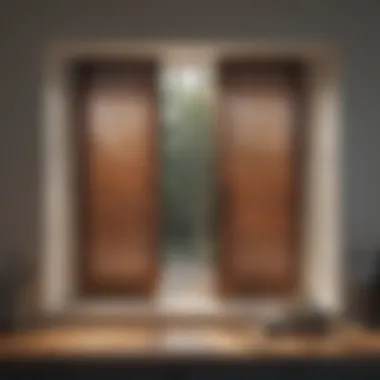

Final Adjustments
Final adjustments can make a significant difference in the functionality of the shutters. Checking how well they open and close is essential. Make any necessary adjustments to hinges or brackets for optimal performance. The end goal is to ensure that the shutters are both visually appealing and functionally sound, encouraging satisfaction with the final product.
Remember, attention to detail during the installation process leads to a more durable and aesthetically pleasing result.
Common Errors and How to Avoid Them
Replacing window shutters can transform the aesthetic and functionality of your home. However, some common errors can undermine the project's success. Recognizing these errors and knowing how to avoid them is essential for both efficiency and quality outcomes. These mistakes include inaccurate measurements and improper installation techniques. Addressing these issues can save time, money, and effort in the long run.
Measuring Mistakes
Double-Checking Dimensions
Double-checking dimensions is a vital step in the shutter replacement process. Taking precise measurements ensures that the new shutters fit properly, avoiding gaps or misalignment. A key characteristic of this practice is its simplicity; all it requires is a measuring tape and a little patience.
This approach is a beneficial choice because it can prevent costly errors. It eliminates the frustration of having to re-order or modify shutters after they have been purchased. The unique feature of double-checking dimensions is that it accounts for any inconsistencies in window size. Windows may not be perfectly square, which means one measurement alone may not provide the full picture. While double-checking takes a bit of time, the advantages far outweigh this small investment.
Understanding Shutter Proportions
Understanding shutter proportions is another critical aspect of ensuring a successful installation. Proportions refer to the size relationship between the shutter and the window itself. A key characteristic of this concept is visual balance; correctly proportioned shutters enhance the overall look of a home.
This aspect is beneficial because it contributes to both functionality and style. Well-proportioned shutters are not only aesthetically pleasing but also operate smoothly. The unique feature of this understanding lies in how it integrates design with practicality. Proper proportions can prevent openings from being obstructed or hindered. A misstep here can lead to shutters that either overpower the window or appear too small, negatively impacting the home's exterior.
Improper Installation Techniques
Aligning Hinges Accurately
Aligning hinges accurately is crucial for ensuring that window shutters operate properly. Misalignment may lead to difficulties in opening and closing the shutters and can also cause undue wear. The key characteristic of this action is precision; hinges must be positioned correctly to allow smooth movement.
This practice is a beneficial choice since proper alignment enhances usability and prolongs the life of the shutters. The unique feature of aligning hinges is that it requires attention to detail. Even a small mistake can result in larger problems down the line, including more extensive repairs or replacements.
Using the Correct Fasteners
Using the correct fasteners during installation is another essential element of the process. Fasteners hold shutters securely in place and contribute to their stability. The key characteristic of this step is material compatibility; different shutters may require different types of screws or brackets.
This element is necessary because incorrect fasteners can result in weak attachments, which may lead to shutters falling or becoming damaged. The unique feature of using the correct fasteners is its impact on safety. Fasteners designed specifically for shutter materials will not only secure the product but also ensure that it can withstand the environmental conditions. Choosing the right fasteners can be the difference between a successful installation and one fraught with problems.
"Attention to detail is paramount in ensuring that the replacement process is smooth and successful."
By addressing these common errors, homeowners can effectively replace their window shutters, leading to an improved appearance and functionality. Whether it's measuring, aligning, or fastening, each aspect contributes significantly to the overall success of the project.
Post-Installation Considerations
Post-installation considerations hold significant importance in the process of replacing window shutters. Once you have successfully completed the installation, it is essential to ensure that everything is functioning properly. This phase ensures that you not only enjoy the aesthetic benefits of your new shutters but also achieve optimal functionality that contributes to your home's comfort and energy efficiency.
Testing Functionality
Ensuring Smooth Operation
Ensuring smooth operation is a critical component after installing new window shutters. This aspect involves testing each shutter to guarantee that they open and close seamlessly. Smooth operation enhances the user experience and indicates proper installation.
The key characteristic here is the alignment of the shutters. When shutters are aligned correctly, they operate more efficiently, reducing strain on their mechanisms. This aspect becomes a beneficial choice for maintaining the longevity of your shutters and preventing future operational issues. A unique feature of ensuring smooth operation is the ability to adjust hinges and latches. Making these adjustments can enhance the performance of the shutters, leading to fewer repairs or replacements in the long run. However, over-adjustment can lead to further issues, which should be done carefully.
Adjusting for Fit
Adjusting for fit is another crucial step in the post-installation process. Once the shutters are in place, it is essential to assess their fit against the window frame. This adjustment ensures that there are no gaps that could compromise energy efficiency or security.
The key characteristic of adjusting for fit lies in ensuring complete closure of the shutters without excessive pressure. This careful calibration is vital for achieving a snug fit, which enhances both aesthetics and functionality. Adjusting for fit is a popular choice among homeowners aiming for a polished look. A unique feature of this process is the method of using shims to modify alignment. While this can lead to a better fit, incorrect placement may cause additional challenges in the future, requiring close attention during this stage.
Maintenance Practices
Regular Cleaning Techniques
Regular cleaning techniques are necessary to prolong the life of your new window shutters. Dust and dirt can accumulate over time, affecting both aesthetics and functionality of the shutters. Establishing a routine cleaning regimen can prevent such issues.
The key characteristic of these techniques is their simplicity and effectiveness. Basic cleaning methods, such as using a soft cloth or gentle cleaning solution, are beneficial choices for any homeowner. A unique aspect of regular cleaning is the use of vacuum attachments for hard-to-reach areas, which can significantly assist in maintaining the appearance of the shutters. However, heavy-duty cleaners should be avoided, as they can damage the finishes of certain materials.
Inspecting for Damage
Inspecting for damage is an integral part of maintaining your window shutters. Regular inspections help identify any potential issues early, allowing for timely repairs. Addressing damage quickly can significantly extend the lifespan of your shutters.
The key characteristic of inspecting for damage lies in its proactive approach. This method is highly beneficial as it helps preserve both functionality and aesthetic appeal. A unique feature of this practice involves checking for signs of wear such as scratches, warping, or hardware issues. Ignoring these signs can lead to more complicated repairs or even replacement.
Regular post-installation checks can significantly enhance your home’s comfort and longevity of your investment in window shutters.
Epilogue
In the journey of replacing window shutters, the conclusion serves multiple important purposes that are critical to the overall success of the task. First and foremost, it encapsulates all the steps and considerations outlined throughout the guide, reinforcing the necessity of careful planning and execution. Beyond merely summarizing, the conclusion provides a moment for reflection on the benefits that come with the new installations.
One of the significant advantages of replacing window shutters is enhanced functionality. New shutters can offer better light control and improved energy efficiency, which in turn contribute to a more comfortable living environment. Offsetting these practical benefits is the aesthetic upgrade that fresh shutters provide. Homeowners appreciate how modern designs can transform the overall appearance of their homes, aligning with their personal style and enhancing curb appeal.
Moreover, engaging in the process described in this guide encourages homeowners to take ownership of their home improvement projects. This not only fosters a sense of accomplishment but also provides a valuable opportunity to learn new skills and gain confidence in tackling future renovations.
Remember that proper maintenance post-installation is essential for longevity and continued satisfaction. By routinely caring for their new shutters, homeowners can preserve their appearance and functionality, ensuring that their investment continues to pay off in the long run.
Finally, the conclusion acts as a call to action. It encourages readers to implement the insights gained from this guide, empowering them to create an environment that reflects their taste while meeting their practical needs. By thoroughly understanding the elements of shutter replacement, homeowners can enjoy a seamless and rewarding upgrade, standing as a testament to thoughtful home improvement.
